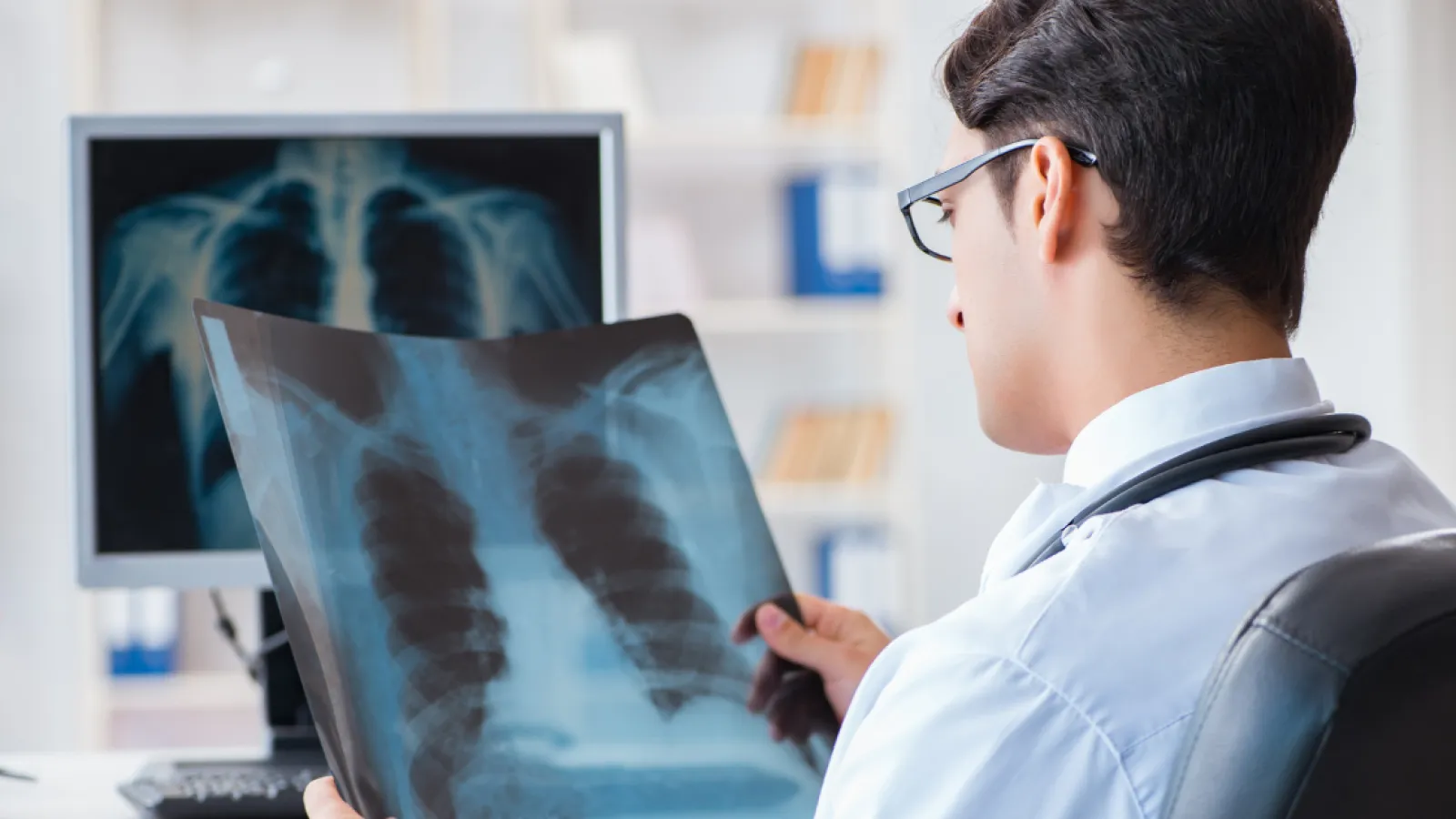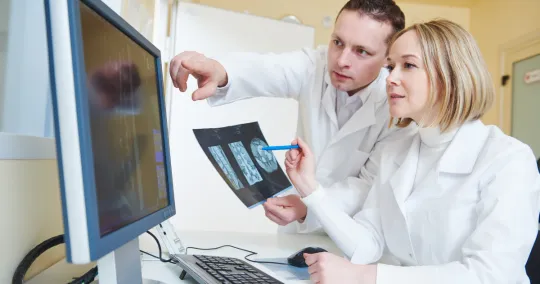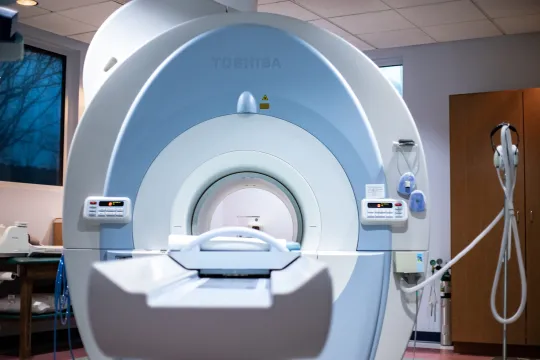
Diagnostic Imaging and MRI Scan Clinic in Lexington, KY
What is Diagnostic Imaging?
Diagnostic imaging includes a variety of techniques that allow doctors to see inside your body to find the cause of an illness or injury and confirm a diagnosis. The type of imaging used depends on your injury or symptoms and the area of your body that needs to be examined. Most of these tests are noninvasive and aid doctors in diagnosing and treating various injuries and diseases.

What are the Different Types of Diagnostic Imaging Available?
The specialists at Bluegrass Orthopaedics are proud to offer various diagnostic imaging services at our convenient Lexington, KY locations. These include MRI, X-ray, and Ultrasound. The MRI scanners provide the highest-quality resolution and comprehensive diagnostic study and have many clinical applications.
What is Diagnostic Imaging Used to Detect?
Your doctor will recommend the best diagnostic imaging services for your unique symptoms and complications. Each of these services is helpful in the diagnosis and treatment of certain conditions. Standard diagnostic imaging services and their uses include:
- MRI: These scans provide an in-depth look inside your body and aid doctors with examining conditions like spine and brain abnormalities, abdominal or liver disease, joint abnormalities and injuries, and cysts.
- X-ray:—This process lets doctors get a clear image of your bones. They can then diagnose injuries such as fractured or injured bones and joints.
- Ultrasounds allow doctors to examine and diagnose conditions related to obstetrics, abdominal issues, and some musculoskeletal issues.
If you've suffered an injury and need immediate care, these services are available at our orthopedic urgent care walk-in clinic. Don't waste time and money with the emergency room; visit one of our specialists today.
Who Needs Diagnostic Imaging?
Diagnostic imaging is an essential tool in the early detection of certain conditions. Many conditions are hard to identify in their early stages due to common symptoms like mild pain or fatigue. Diagnostic imaging allows doctors to diagnose these conditions and provide a thorough treatment plan.
Orthopedic injuries often require diagnostic imaging to aid your doctor's diagnosis or treatment. While some orthopedic injuries may heal with home remedies such as rest, ice, compression, and over-the-counter anti-inflammatory medications, more severe injuries will require some form of diagnostic imaging. Contact us to learn more.
What are the Advantages of Digital Diagnostic Imaging?
The state-of-the-art digital diagnostic equipment at Bluegrass Orthopaedics allows our top-rated specialists to provide faster and more efficient results. These digital images can be emailed to doctors, allowing them to view the images anywhere and make on-the-spot assessments. This allows our physicians to deliver answers to patients and create a treatment plan much faster than traditional imaging services.
Diagnostic Imaging Services in Lexington, KY
At Bluegrass Orthopaedics, we are dedicated to providing the best care to our patients. Our diagnostic imaging specialists are here to help diagnose and create a treatment plan for your acute and chronic conditions. Book an appointment online or visit our orthopedic urgent walk-in clinic today.
Serving
Near You
Preparing for Your MRI
You may eat normally and go about your daily routine. Continue to take any medication prescribed by your doctor unless otherwise directed. Depending on the scan you are having you may be asked to put on paper shorts and/or scrub top and asked to remove dentures. If you are able to wear comfortable clothing without buckles or zippers, you will hopefully not be asked to change. This would include wearing a sports bra for female patients with upper body scans if possible.
If your job requires you to work in an area where there are fine metal shavings or metal dust particles in the air, you will need to go home and shower and put clean clothing on before coming for the scan. The magnet will pull these particles out of your hair or off your clothing and it will damage the magnet.
Because of the potential harmful effects associated with metallic objects in a magnetic field, you should check with the MRI technologist if you have had any surgeries or any of the following. Please check with the MRI technologist prior to arriving for the scan because with some of these you are not able to have a MRI.
- Pacemaker
- Aneurysm Clips
- Foreign Metal Objects In the Eye
- Neuro-Stimulator (Tens Unit)
- Surgical Staples
- Shrapnel or Bullet Wounds
- Implanted Drug Infusion Device
- Permanent Eyeliner
If you are pregnant you should notify your physician.
Please contact our High Field Short Bone MRI Department at (859) 422-4566 Ext. 502
Because of the magnetic field, you will be asked to leave the following items in a locker outside the scan room:
- Coins
- Watches
- Credit Cards/Wallet
- Hair Pins
- Jewelry
- Glasses
- Keys
- Other Metal Objects
WE CAN HELP
WITH WHAT YOU NEED
-
Shoulder
-
Telemedicine
-
Orthopaedics
-
Foot &
Ankle -
Physical
Therapy -
Fracture
Care -
MRI &
Imaging -
Hand &
Wrist -
Hip
-
Pain
Management -
Knee
-
Spine
-
Sports
Medicine -
Total
Joint -
Work
Injuries -
EMG/NCV
Testing -
Walk-In
Clinic -
Elbow
Pain -
Bunion
Removal -
Foot and Ankle
Arthritis -
Patellar Tendonitis (Jumper’s
Knee) -
Knee
Bursitis -
Rotator Cuff
Surgery -
Shoulder Replacement
Surgery -
Trigger
Finger -
Hand
Fracture -
Hand and Wrist
Tendonitis -
Tennis
Elbow -
Osteoporosis
-
Herniated
Disc -
Acute Joint
Pain -
Closed
Fracture -
Aggravated Knee
Injury -
Sprains and
Strains -
Reconstructive Foot and
Ankle -
Swollen
Joint -
Osteoarthritis
-
Elbow
Fracture
The scanner does not expose you to any radiation as does a regular x-ray. Instead, the scanner uses a giant magnet coil to generate a magnetic field that interacts with the tissues of the body. A computer then interprets all the different signals and generates an image of the part that is examined. This means it provides a faster exam time for patients, provides the doctors with a more detailed image and relieves the problem of claustrophobia.
In order to be scanned, the patient must lie down on a bed that is slowly moved into a tunnel. However, this MRI provides a full foot of space above the patient's head and it is among the shortest tunnel MRI on the market. There is no pain or discomfort and no known side effects.
